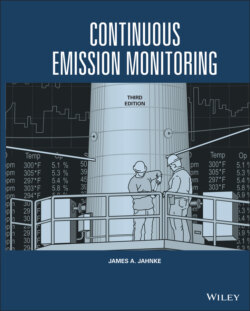Читать книгу Continuous Emission Monitoring - James A. Jahnke - Страница 101
The STI Probe.
ОглавлениеThe first external dilution probe was developed to address plugging of dilution orifices by water droplets in the EPM probe by Sampling Technology, Inc. (STI) and is available from STI and Thermo Fisher Scientific (Figure 3‐24). This external dilution system, made of Torlon, is shown in Figure 3‐24 (Fischer 1993). It again uses an ejector pump to extract the sample from the stack and has been popular in pulp and paper industry applications, particularly after wet scrubbers. The flue gas sample extracted at low flow rates is first filtered by a tubular filter, where particulate matter and aerosols not dropping out in the probe are collected. A quartz capillary serves as the critical orifice, which controls the sample gas flow rate. The sample gas combines with the ejector pump air as in other dilution systems described.
As mentioned previously, one advantage of an external dilution system is that an undiluted sample can be first sent to an O2 analyzer before it proceeds to the dilution system. This provides an alternative to using a CO2 analyzer for the diluent monitor. A separate sample line can be installed after the probe filter, but before the dilution orifice, to draw an undiluted sample. This sample can then be conditioned to remove water vapor and analyzed with an oxygen sensor.
An alternative approach to external dilution systems is to transport the gas from the stack in the traditional manner of a source‐level extractive system and to dilute the gas in the CEM shelter. This does provide for rapid gas transport, but a heated sample line must be used. This approach loses one of the principal advantages of dilution systems – their ability to deliver the sample to the analyzers with unheated sample line.
